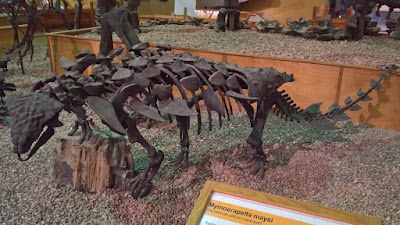New article supports the "bloat and float" model for ankylosaur post mortem transport
Ankylosaurs are the group, maybe with the exception of hadrosaurs, that are more commonly found turned upside down, while at the same time also in a marine facies setting. The reasons for the upside down occurrences have been attributed to either the clumsiness of ankylosaurs caused by their massive bulk (Nopcsa, 1928), predation by large theropods (Nopcsa, 1928), what Carpenter (1984) proposed as the "armadillo roadkill model", or because of the action of decomposition gases that would make the carcass bloat and float, the weight of the extensive ossification in the upper portion of the body causing it to turn belly up. However, none of these hypothesis have been properly tested until recently.
A new article, by Jordan Mallon and colleagues, in press by the journal Palaeogeography, Palaeoclimatology, Palaeoecology, addresses the issue by quantifying and using modeling approaches, and produced strong statistical support for the upside-down occurrences and the "bloat and float" model. It also analyses the differential floating behavior between ankylosaurids and nodosaurids, and the possible implications regarding the occurrence of the latter in marine depositional environments. In addition, there might be a parallel to be found with the purported frequency of overturned glyptodonts, which share a similar bauplan with ankylosaurs.
A new article, by Jordan Mallon and colleagues, in press by the journal Palaeogeography, Palaeoclimatology, Palaeoecology, addresses the issue by quantifying and using modeling approaches, and produced strong statistical support for the upside-down occurrences and the "bloat and float" model. It also analyses the differential floating behavior between ankylosaurids and nodosaurids, and the possible implications regarding the occurrence of the latter in marine depositional environments. In addition, there might be a parallel to be found with the purported frequency of overturned glyptodonts, which share a similar bauplan with ankylosaurs.



Comments
Post a Comment